人教新目标版英语七年级下Unit 3 How do you get to school?Section B 2a-2c说课教案(1课时)
文档属性
| 名称 | 人教新目标版英语七年级下Unit 3 How do you get to school?Section B 2a-2c说课教案(1课时) | 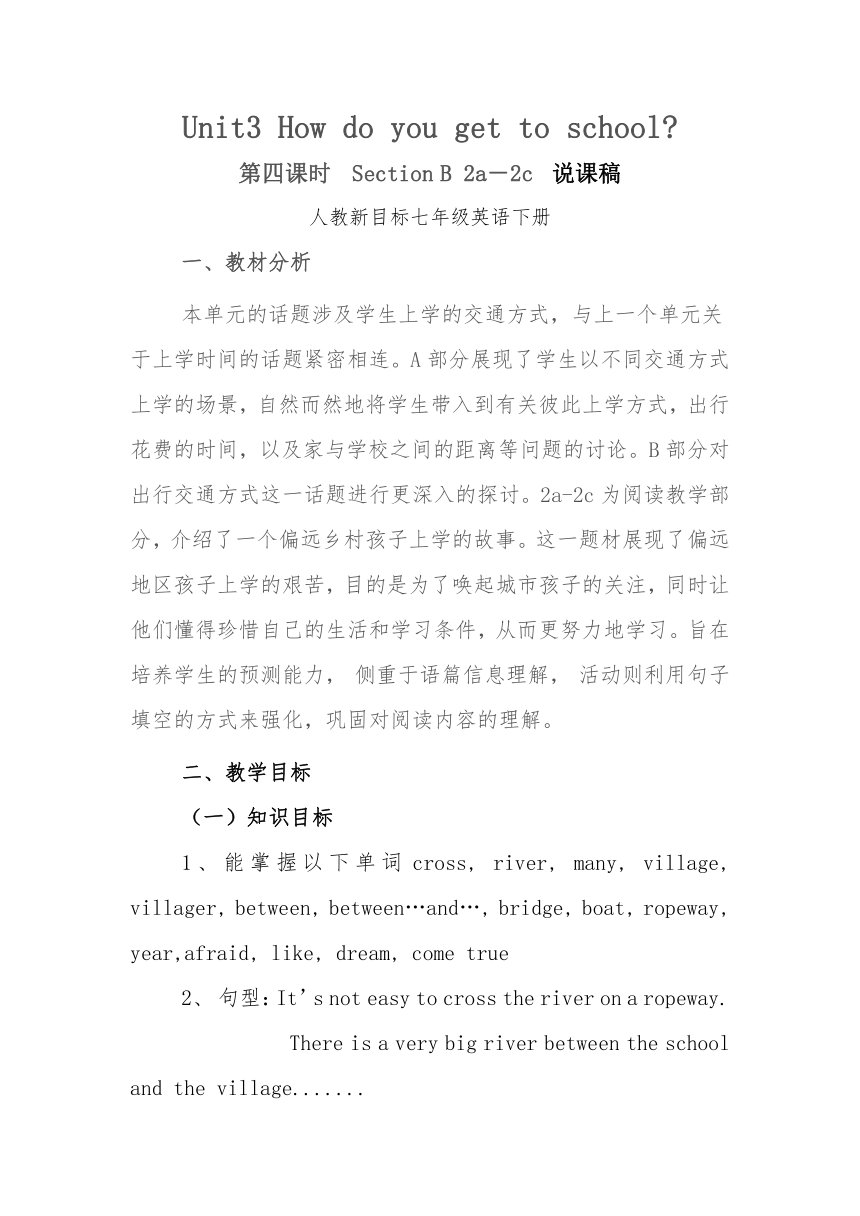 | |
| 格式 | docx | ||
| 文件大小 | 65.3KB | ||
| 资源类型 | 教案 | ||
| 版本资源 | 人教新目标(Go for it)版 | ||
| 科目 | 英语 | ||
| 更新时间 | 2022-03-19 22:28:00 | ||
图片预览

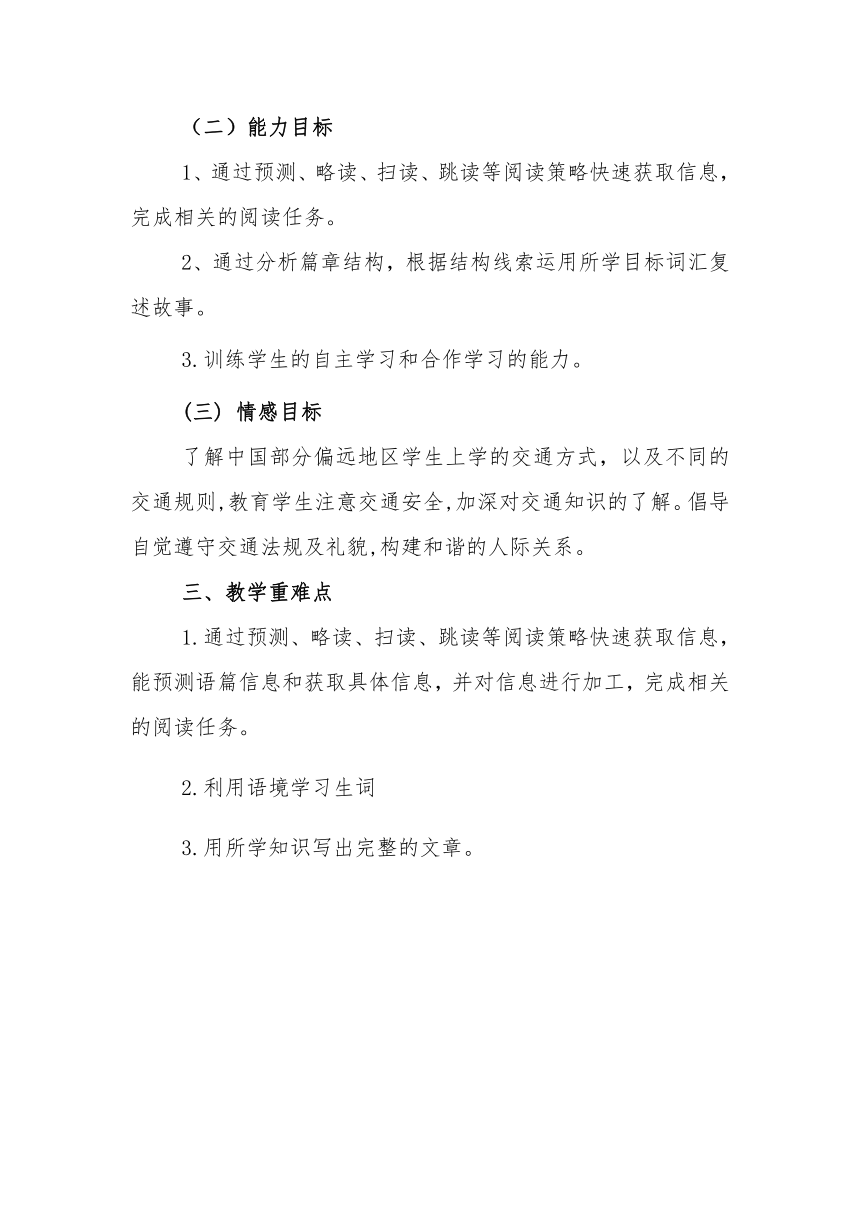
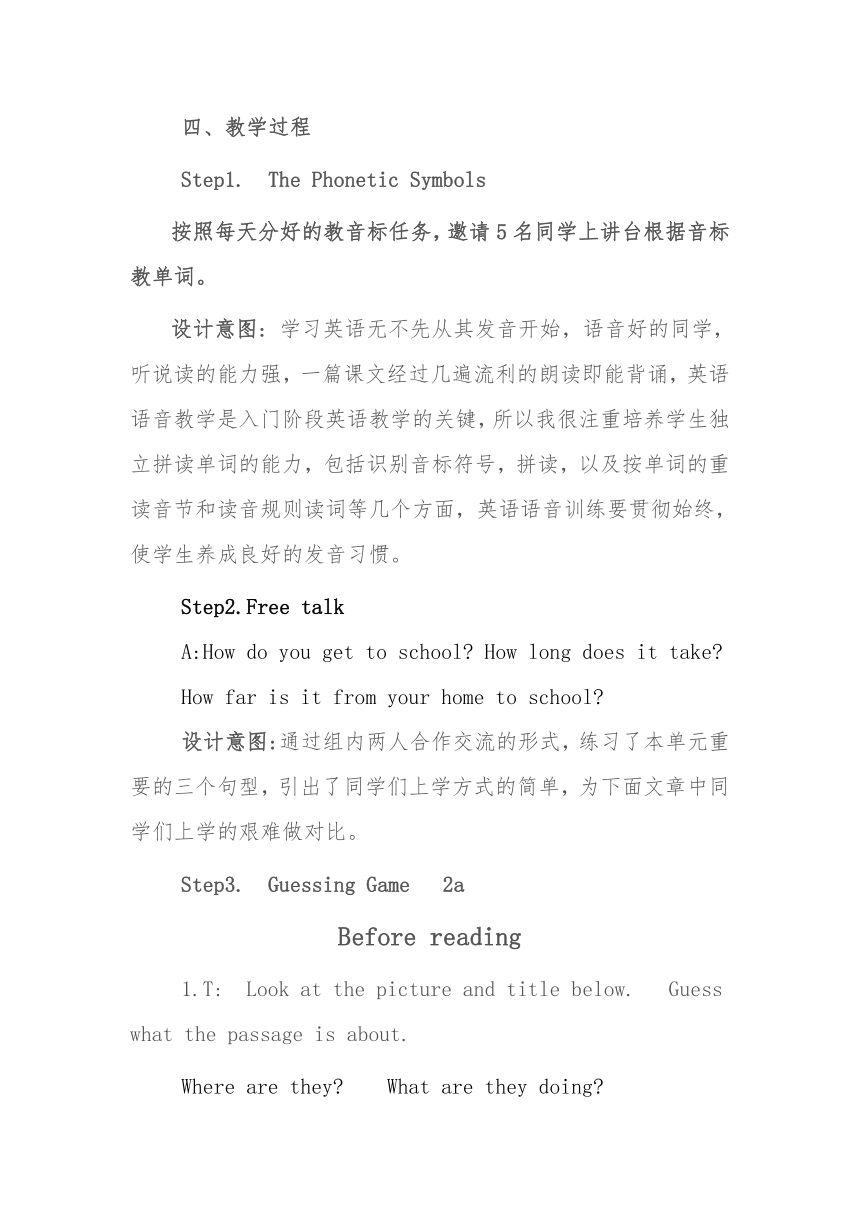
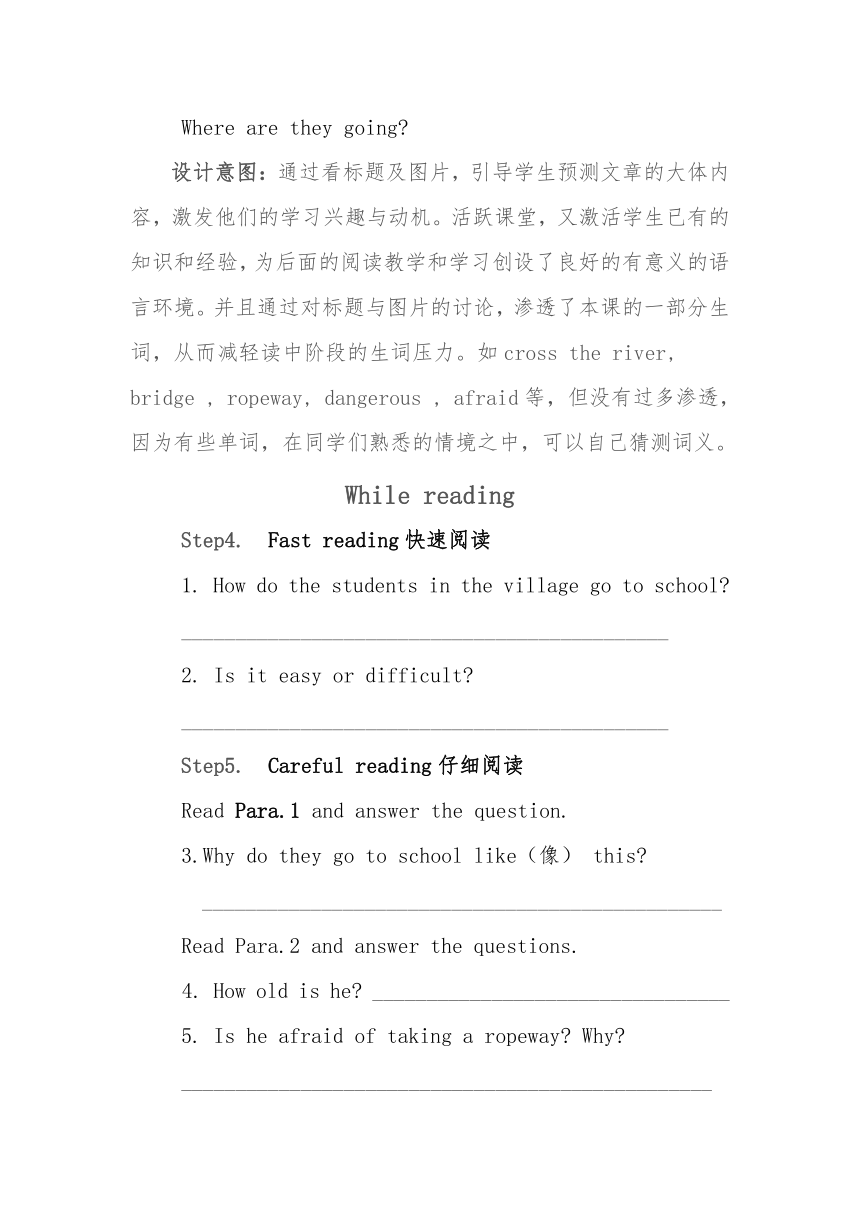
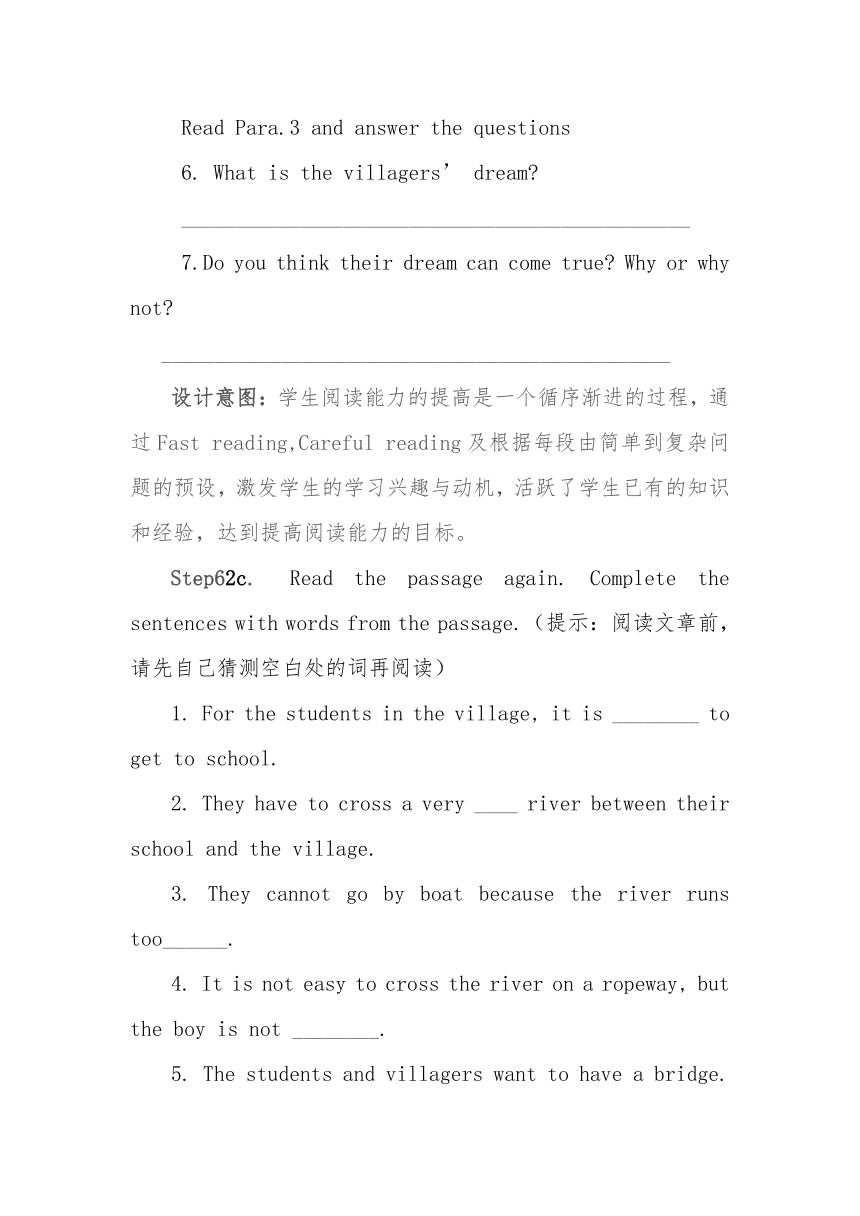
文档简介
Unit3 How do you get to school
第四课时 Section B 2a-2c 说课稿
人教新目标七年级英语下册
一、教材分析
本单元的话题涉及学生上学的交通方式,与上一个单元关于上学时间的话题紧密相连。A部分展现了学生以不同交通方式上学的场景,自然而然地将学生带入到有关彼此上学方式,出行花费的时间,以及家与学校之间的距离等问题的讨论。B部分对出行交通方式这一话题进行更深入的探讨。2a-2c为阅读教学部分,介绍了一个偏远乡村孩子上学的故事。这一题材展现了偏远地区孩子上学的艰苦,目的是为了唤起城市孩子的关注,同时让他们懂得珍惜自己的生活和学习条件,从而更努力地学习。旨在培养学生的预测能力, 侧重于语篇信息理解, 活动则利用句子填空的方式来强化,巩固对阅读内容的理解。
二、教学目标
(一)知识目标
1、能掌握以下单词cross, river, many, village, villager, between, between…and…, bridge, boat, ropeway, year,afraid, like, dream, come true
2、 句型:It’s not easy to cross the river on a ropeway.
There is a very big river between the school and the village.......
(二)能力目标
1、通过预测、略读、扫读、跳读等阅读策略快速获取信息,
完成相关的阅读任务。
2、通过分析篇章结构,根据结构线索运用所学目标词汇复述故事。
3.训练学生的自主学习和合作学习的能力。
(三) 情感目标
了解中国部分偏远地区学生上学的交通方式,以及不同的交通规则,教育学生注意交通安全,加深对交通知识的了解。倡导自觉遵守交通法规及礼貌,构建和谐的人际关系。
三、教学重难点
1.通过预测、略读、扫读、跳读等阅读策略快速获取信息,能预测语篇信息和获取具体信息,并对信息进行加工,完成相关的阅读任务。
2.利用语境学习生词
3.用所学知识写出完整的文章。
四、教学过程
Step1. The Phonetic Symbols
按照每天分好的教音标任务,邀请5名同学上讲台根据音标教单词。
设计意图: 学习英语无不先从其发音开始,语音好的同学,听说读的能力强,一篇课文经过几遍流利的朗读即能背诵,英语语音教学是入门阶段英语教学的关键,所以我很注重培养学生独立拼读单词的能力,包括识别音标符号,拼读,以及按单词的重读音节和读音规则读词等几个方面,英语语音训练要贯彻始终,使学生养成良好的发音习惯。
Step2.Free talk
A:How do you get to school How long does it take
How far is it from your home to school
设计意图:通过组内两人合作交流的形式,练习了本单元重要的三个句型,引出了同学们上学方式的简单,为下面文章中同学们上学的艰难做对比。
Step3. Guessing Game 2a
Before reading
1.T: Look at the picture and title below. Guess what the passage is about.
Where are they What are they doing
Where are they going
设计意图:通过看标题及图片,引导学生预测文章的大体内容,激发他们的学习兴趣与动机。活跃课堂,又激活学生已有的知识和经验,为后面的阅读教学和学习创设了良好的有意义的语言环境。并且通过对标题与图片的讨论,渗透了本课的一部分生词,从而减轻读中阶段的生词压力。如cross the river, bridge , ropeway, dangerous , afraid等,但没有过多渗透,因为有些单词,在同学们熟悉的情境之中,可以自己猜测词义。
While reading
Step4. Fast reading快速阅读
1. How do the students in the village go to school
_____________________________________________
2. Is it easy or difficult
_____________________________________________
Step5. Careful reading仔细阅读
Read Para.1 and answer the question.
3.Why do they go to school like(像) this
________________________________________________
Read Para.2 and answer the questions.
4. How old is he _________________________________
5. Is he afraid of taking a ropeway Why
_________________________________________________
Read Para.3 and answer the questions
6. What is the villagers’ dream
_______________________________________________
7.Do you think their dream can come true Why or why not
_______________________________________________
设计意图:学生阅读能力的提高是一个循序渐进的过程,通过Fast reading,Careful reading及根据每段由简单到复杂问题的预设,激发学生的学习兴趣与动机,活跃了学生已有的知识和经验,达到提高阅读能力的目标。
Step62c. Read the passage again. Complete the sentences with words from the passage.(提示:阅读文章前,请先自己猜测空白处的词再阅读)
1. For the students in the village, it is ________ to get to school.
2. They have to cross a very ____ river between their school and the village.
3. They cannot go by boat because the river runs too______.
4. It is not easy to cross the river on a ropeway, but the boy is not ________.
5. The students and villagers want to have a bridge. Can their dream come ______
(设计意图:通过2b材料的 Fast reading 和Careful reading及问题的预设与处理,让学生通过填空的方式来强化、巩固对阅读材料的理解,我先让同学们自己试着填,因为答案均为描述性词语,该活动也是对这些形容词、副词的巩固,又激活学生已有的知识和经验,注重了阅读策略的培养。)
Step 7.合作探究(请同学们独立完成,再在小组内交流)
1. For many students, it is easy to get to school.
对于许多学生来说,上学很容易。
(对某人来说)做某事怎么样_________________________
(1)It’s easy for me ____________my homework. (finish)
(2) It’s difficult for him _________up early .(get)
2. There is a very big river between their school and the village.
在他们的学校和乡村之间有一条大河。
在……和……之间__________________________________
There is a Yuxi River ________________________________
我家和学校之间有一条榆溪河。
3. There is no bridge and the river runs too quickly for boats.
run ,在不同语境中分别有不同的用法和含义。
I run to my room and get my bag. run 意思是________
The river runs too quickly for boats. run 意思是________
4. One 11-year-old boy, Liangliang, crosses the river every school day.
亮亮,一个11岁男孩,每天过河上学。
11-year-old“11岁的” 构成一个复合_______,修饰名词boy。
I am a ______________________(14岁)boy/girl.
5. But he is not afraid. 但是他不害怕。
_____________________ 害怕做某事
_____________________. 怕某事/某人
6. He’s like a father to me. 对于我来说,他像一个父亲。
be like_______
___________________________我像我妈妈。
2) like v. 喜欢 __________________________我喜欢打篮球。
7. Many of the students and villagers never leave the village.
__________村庄 _________村民
leave+ 地点 + for + 地点”表示“离开某地去某地”
I will __________________Beijing我要离开榆林去北京。
Step 8.反馈展示
对以上的语言学习中存在的疑难问题,请提问并请其他组同学帮忙解决。
设计意图:通过自学,小组讨论来培养学生的合作,协调和探究能力,并设计一些题来对语言点加以突破。教师适时加以点拔,增强学生运用语言的能力。
Step 9.巩固拓展
After reading
I can retell......
(请同学们先试着自己复述,再在小组内集体展示)
For many students, it is _____to get to school, but there is one ___________boy, Liangliang, lives in a small________, it is __________for him to get to school. There is a very big river _______their school _______the village, there is no ________,the river runs too ______for ______,so they ________________to cross the river to school, but he is not ________, because he loves his _________,he loves to ____________his classmates, he loves his _________,he is ______a father to Liangliang.They never _________the village, they have a _________:to have a _________.Can their dream______________
设计意图:《中学英语教学法》中强调,背诵是初中阶段朗读训练应达到的要求之一,背诵有助于熟记语言材料,积累语言知识,有利于听,说,读,写技能的发展,七年级一般要求背诵全课文,通过这些关键词或者提示先复述课文,以帮助学生顺利地完成背诵练习,不要给学困生太大的背诵压力。
Step9课后检测
Be a good writer.
同学们,假如你是亮亮,请就以下问题给编辑写一封信,请求他的帮助。
1.Where do you live 2.What time do you get up
3.How far is it from your home to school
4.How do you get to school Why
5.How long does it take
6. Are you afraid 7.What’s your dream
Dear editor(编辑),
Ineed your help. My name is_______________________
____________________________________________________
Liangliang
二、根据汉语意思完成句子,每空一词
我们学校有200个老师。
two _______ teachers in our school.
许多村民从没见过火车。
______ _______ never see a train .
他们的梦想会实现的。
Their______ can _______ ________.
他喜欢和我们玩。
He loves to _________ ________ us.
5. 他们不能坐船上学,因为河流得太快了。
They can’t go to school by _______because the river _______ too ________.
设计意图:假设同学们自己是亮亮,给编辑写一封求助信,通过写,让同学们从内心体会亮亮上学的艰难,达到学中用,用中学,学以致用,提高学生的听说读写能力,而且也让同学们明白,每个人都需要帮助,每个人都可以帮助别人, 我们互相帮助,才能实现彼此的梦想,世界才能更美好。
(
Unit3 How do you get to school
Section B 2a-2c
)五、板书设计
第四课时 Section B 2a-2c 说课稿
人教新目标七年级英语下册
一、教材分析
本单元的话题涉及学生上学的交通方式,与上一个单元关于上学时间的话题紧密相连。A部分展现了学生以不同交通方式上学的场景,自然而然地将学生带入到有关彼此上学方式,出行花费的时间,以及家与学校之间的距离等问题的讨论。B部分对出行交通方式这一话题进行更深入的探讨。2a-2c为阅读教学部分,介绍了一个偏远乡村孩子上学的故事。这一题材展现了偏远地区孩子上学的艰苦,目的是为了唤起城市孩子的关注,同时让他们懂得珍惜自己的生活和学习条件,从而更努力地学习。旨在培养学生的预测能力, 侧重于语篇信息理解, 活动则利用句子填空的方式来强化,巩固对阅读内容的理解。
二、教学目标
(一)知识目标
1、能掌握以下单词cross, river, many, village, villager, between, between…and…, bridge, boat, ropeway, year,afraid, like, dream, come true
2、 句型:It’s not easy to cross the river on a ropeway.
There is a very big river between the school and the village.......
(二)能力目标
1、通过预测、略读、扫读、跳读等阅读策略快速获取信息,
完成相关的阅读任务。
2、通过分析篇章结构,根据结构线索运用所学目标词汇复述故事。
3.训练学生的自主学习和合作学习的能力。
(三) 情感目标
了解中国部分偏远地区学生上学的交通方式,以及不同的交通规则,教育学生注意交通安全,加深对交通知识的了解。倡导自觉遵守交通法规及礼貌,构建和谐的人际关系。
三、教学重难点
1.通过预测、略读、扫读、跳读等阅读策略快速获取信息,能预测语篇信息和获取具体信息,并对信息进行加工,完成相关的阅读任务。
2.利用语境学习生词
3.用所学知识写出完整的文章。
四、教学过程
Step1. The Phonetic Symbols
按照每天分好的教音标任务,邀请5名同学上讲台根据音标教单词。
设计意图: 学习英语无不先从其发音开始,语音好的同学,听说读的能力强,一篇课文经过几遍流利的朗读即能背诵,英语语音教学是入门阶段英语教学的关键,所以我很注重培养学生独立拼读单词的能力,包括识别音标符号,拼读,以及按单词的重读音节和读音规则读词等几个方面,英语语音训练要贯彻始终,使学生养成良好的发音习惯。
Step2.Free talk
A:How do you get to school How long does it take
How far is it from your home to school
设计意图:通过组内两人合作交流的形式,练习了本单元重要的三个句型,引出了同学们上学方式的简单,为下面文章中同学们上学的艰难做对比。
Step3. Guessing Game 2a
Before reading
1.T: Look at the picture and title below. Guess what the passage is about.
Where are they What are they doing
Where are they going
设计意图:通过看标题及图片,引导学生预测文章的大体内容,激发他们的学习兴趣与动机。活跃课堂,又激活学生已有的知识和经验,为后面的阅读教学和学习创设了良好的有意义的语言环境。并且通过对标题与图片的讨论,渗透了本课的一部分生词,从而减轻读中阶段的生词压力。如cross the river, bridge , ropeway, dangerous , afraid等,但没有过多渗透,因为有些单词,在同学们熟悉的情境之中,可以自己猜测词义。
While reading
Step4. Fast reading快速阅读
1. How do the students in the village go to school
_____________________________________________
2. Is it easy or difficult
_____________________________________________
Step5. Careful reading仔细阅读
Read Para.1 and answer the question.
3.Why do they go to school like(像) this
________________________________________________
Read Para.2 and answer the questions.
4. How old is he _________________________________
5. Is he afraid of taking a ropeway Why
_________________________________________________
Read Para.3 and answer the questions
6. What is the villagers’ dream
_______________________________________________
7.Do you think their dream can come true Why or why not
_______________________________________________
设计意图:学生阅读能力的提高是一个循序渐进的过程,通过Fast reading,Careful reading及根据每段由简单到复杂问题的预设,激发学生的学习兴趣与动机,活跃了学生已有的知识和经验,达到提高阅读能力的目标。
Step62c. Read the passage again. Complete the sentences with words from the passage.(提示:阅读文章前,请先自己猜测空白处的词再阅读)
1. For the students in the village, it is ________ to get to school.
2. They have to cross a very ____ river between their school and the village.
3. They cannot go by boat because the river runs too______.
4. It is not easy to cross the river on a ropeway, but the boy is not ________.
5. The students and villagers want to have a bridge. Can their dream come ______
(设计意图:通过2b材料的 Fast reading 和Careful reading及问题的预设与处理,让学生通过填空的方式来强化、巩固对阅读材料的理解,我先让同学们自己试着填,因为答案均为描述性词语,该活动也是对这些形容词、副词的巩固,又激活学生已有的知识和经验,注重了阅读策略的培养。)
Step 7.合作探究(请同学们独立完成,再在小组内交流)
1. For many students, it is easy to get to school.
对于许多学生来说,上学很容易。
(对某人来说)做某事怎么样_________________________
(1)It’s easy for me ____________my homework. (finish)
(2) It’s difficult for him _________up early .(get)
2. There is a very big river between their school and the village.
在他们的学校和乡村之间有一条大河。
在……和……之间__________________________________
There is a Yuxi River ________________________________
我家和学校之间有一条榆溪河。
3. There is no bridge and the river runs too quickly for boats.
run ,在不同语境中分别有不同的用法和含义。
I run to my room and get my bag. run 意思是________
The river runs too quickly for boats. run 意思是________
4. One 11-year-old boy, Liangliang, crosses the river every school day.
亮亮,一个11岁男孩,每天过河上学。
11-year-old“11岁的” 构成一个复合_______,修饰名词boy。
I am a ______________________(14岁)boy/girl.
5. But he is not afraid. 但是他不害怕。
_____________________ 害怕做某事
_____________________. 怕某事/某人
6. He’s like a father to me. 对于我来说,他像一个父亲。
be like_______
___________________________我像我妈妈。
2) like v. 喜欢 __________________________我喜欢打篮球。
7. Many of the students and villagers never leave the village.
__________村庄 _________村民
leave+ 地点 + for + 地点”表示“离开某地去某地”
I will __________________Beijing我要离开榆林去北京。
Step 8.反馈展示
对以上的语言学习中存在的疑难问题,请提问并请其他组同学帮忙解决。
设计意图:通过自学,小组讨论来培养学生的合作,协调和探究能力,并设计一些题来对语言点加以突破。教师适时加以点拔,增强学生运用语言的能力。
Step 9.巩固拓展
After reading
I can retell......
(请同学们先试着自己复述,再在小组内集体展示)
For many students, it is _____to get to school, but there is one ___________boy, Liangliang, lives in a small________, it is __________for him to get to school. There is a very big river _______their school _______the village, there is no ________,the river runs too ______for ______,so they ________________to cross the river to school, but he is not ________, because he loves his _________,he loves to ____________his classmates, he loves his _________,he is ______a father to Liangliang.They never _________the village, they have a _________:to have a _________.Can their dream______________
设计意图:《中学英语教学法》中强调,背诵是初中阶段朗读训练应达到的要求之一,背诵有助于熟记语言材料,积累语言知识,有利于听,说,读,写技能的发展,七年级一般要求背诵全课文,通过这些关键词或者提示先复述课文,以帮助学生顺利地完成背诵练习,不要给学困生太大的背诵压力。
Step9课后检测
Be a good writer.
同学们,假如你是亮亮,请就以下问题给编辑写一封信,请求他的帮助。
1.Where do you live 2.What time do you get up
3.How far is it from your home to school
4.How do you get to school Why
5.How long does it take
6. Are you afraid 7.What’s your dream
Dear editor(编辑),
Ineed your help. My name is_______________________
____________________________________________________
Liangliang
二、根据汉语意思完成句子,每空一词
我们学校有200个老师。
two _______ teachers in our school.
许多村民从没见过火车。
______ _______ never see a train .
他们的梦想会实现的。
Their______ can _______ ________.
他喜欢和我们玩。
He loves to _________ ________ us.
5. 他们不能坐船上学,因为河流得太快了。
They can’t go to school by _______because the river _______ too ________.
设计意图:假设同学们自己是亮亮,给编辑写一封求助信,通过写,让同学们从内心体会亮亮上学的艰难,达到学中用,用中学,学以致用,提高学生的听说读写能力,而且也让同学们明白,每个人都需要帮助,每个人都可以帮助别人, 我们互相帮助,才能实现彼此的梦想,世界才能更美好。
(
Unit3 How do you get to school
Section B 2a-2c
)五、板书设计
同课章节目录
- Unit 1 Can you play the guitar?
- Section A
- Section B
- Unit 2 What time do you go to school?
- Section A
- Section B
- Unit 3 How do you get to school?
- Section A
- Section B
- Unit 4 Don't eat in class.
- Section A
- Section B
- Unit 5 Why do you like pandas?
- Section A
- Section B
- Unit 6 I'm watching TV.
- Section A
- Section B
- Review of Units 1-6
- Unit 7 It's raining!
- Section A
- Section B
- Unit 8 Is there a post office near here?
- Section A
- Section B
- Unit 9 What does he look like?
- Section A
- Section B
- Unit 10 I'd like some noodles.
- Section A
- Section B
- Unit 11 How was your school trip?
- Section A
- Section B
- Unit 12 What did you do last weekend?
- Section A
- Section B
